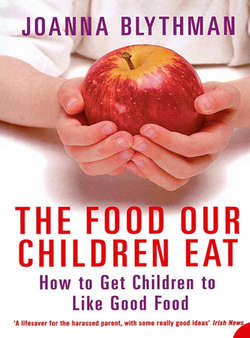Читать книгу The Food Our Children Eat: How to Get Children to Like Good Food - Joanna Blythman, Joanna Blythman - Страница 16
GIFT-WRAPPED JUNK
ОглавлениеHaving difficulty getting your child to eat? Never fear, the processed food industry’s marketing team is here to help. It has devised some super products, designed to be snapped up by the nation’s kiddies and make shopping easy for poor old driven-to-distraction ‘Mum’. Lest she should miss these on her desperate dash round the supermarket, many chains now have helpful signs such as ‘Children’s Desserts’ on those prominent end-of-aisle locations to make them stand out.
Not that these tailor-made products for kids are easy to ignore, either for ‘Mum’ or for her arm-tugging companions. They sing out with brightly coloured images of jolly cartoon characters or the latest collectable toy. And because these familiar images intrigue children – after all they see them over and over again on children’s TV – trying to take a toddler or small child past them without being put under pressure to buy is about as easy as convincing them to walk past a playpark without going in.
The packaging that the images adorn is a triumph of technical wizardry. Anything straightforward is out – after all, we all know that kids have to be bribed into eating food, don’t we? So packaging takes over and generates an endless stream of novelties designed to capture that gullible junior market.
The straightforward old yogurt pot, for example, is out. Now yogurt must come in rigid two-compartment plastic containers with a dinky-doo addition to mix in. Anything goes, from multi-coloured sprinkles to chocolate polka dots or crunchy mini-biscuits – with the caveat that it must be sweet.
If two compartments already seem old hat, then bored children can be further tempted by that little fromage frais that comes with its own toy or handy little spoon. Worried about the environmental impact of all this moulded plastic? Then plump for that reusable container which can be broken down and then remodelled into a constructable toy.
Finding those rolls and sandwiches coming home uneaten in the lunch box? Why not give the kids a miniaturized box so that they can have the fun of assembling their own lunch, sandwiching processed ham and cheese with salty crackers as perfectly as any dovetail joint?
Cheese getting the thumbs-down? What about letting them make their own self-service selection of pick ’n’ mix miniaturised cheeses or trying them out with a runny cheese and dipping biscuits ensemble?
All right, no one these days seriously expects children to eat a bit of whole fish anyway, but what do you do if they begin to reject even fish fingers? Try out fishy shapes with special tails for them to hold as they dip them into that essential ketchup, of course. Dinosaur-shaped Kievs, reconstituted potato with cute little arms and legs or funny faces, condensed milk, fromage frais or yogurt drinks in squeezy tubes to suck at playtime, triangular milk shakes, mini cup cakes topped with a rice-paper image of their favourite cuddly character … so continues the litany of food products targeted at children.
You have to give these products credit for being both ingenious and inventive – as far as food manufacturers are concerned, that is. This endlessly novel repertoire of ‘children’s’ specialities allows them to take heavily processed junk food, gift-wrap it in images guaranteed to appeal to children, then sell it at a tidy profit.
There’s a limit, of course, to how much they can charge for a basic frozen potato shape, fish finger, fromage frais or processed cheese. But once they have succeeded in packaging it for children they can simply sit back and listen to those cash registers ringing. There’s nothing wrong with profits, of course, and manufacturers insist that they are only giving parents a helping hand. What despairing parent with an infamous ‘picky child’ would not be prepared to pay that little premium if these products get him or her to eat something he or she would not otherwise? But the price parents and children pay is quite high if we consider the quality of the food on offer. Real potatoes don’t have arms and legs – to give them these, they need to be moulded together with chemical additives. Cheese doesn’t squirt naturally – a range of chemical emulsifiers and cheap dairy by-products needs to be incorporated first. It seems that the food industry has ordained that all those yogurts and fromage frais prominently featuring images of the latest desirable ‘collectable’ just have to have chemical preservatives and flavourings. In order to process that ham into its easy-to-handle shape, it has to have lots of added water, polyphosphates and the standard flavour enhancers. Not to put too fine a point on it, if we wanted to home in on products stiff with chemical additives, then we need look no further than these gimmicky offerings.
Most of us know that when we buy these children’s novelties we are paying over the odds for something that isn’t that healthy. But we feel desperate. Better they eat something than nothing, we think. And as far back as any of us can remember, there’s been a deep-seated belief that by taking basic ingredients and repackaging them in forms that appeal to children, we can get them to eat what they might otherwise reject.
But is presentation really the best long-term tool to get children to eat? Does every food we offer them have to be disguised with amusing little ears or sugary sprinkles? If you have your doubts and would rather your children ate real food, not gift-wrapped junk, then turn to pages 86–90, Presentation, Boredom and the ‘Yuck’ Reaction, for ideas.
